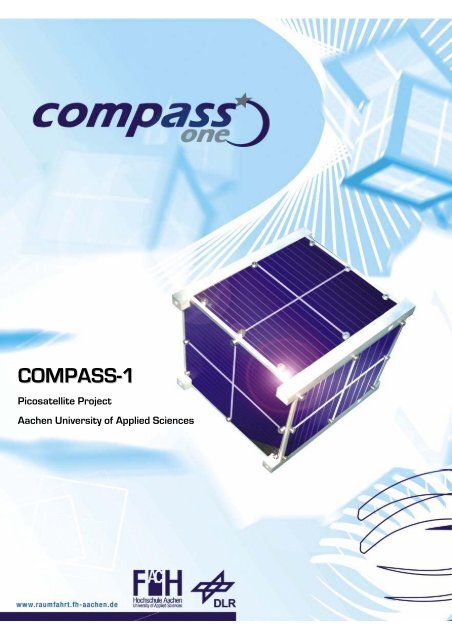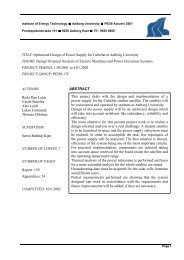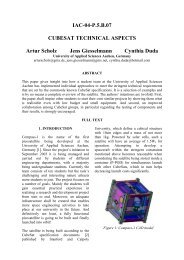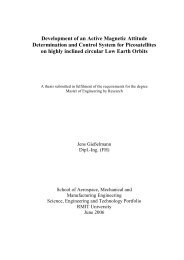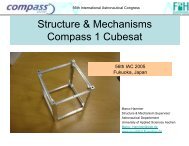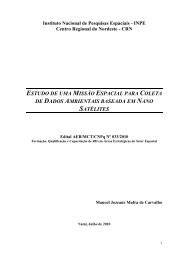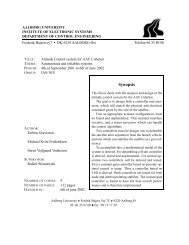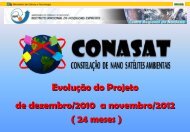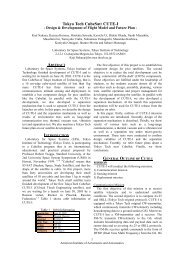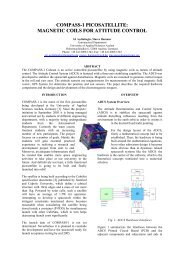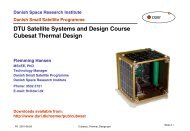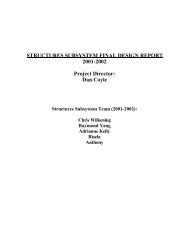Brochure COMPASS-1 - COMPASS - FH Aachen
Brochure COMPASS-1 - COMPASS - FH Aachen
Brochure COMPASS-1 - COMPASS - FH Aachen
Create successful ePaper yourself
Turn your PDF publications into a flip-book with our unique Google optimized e-Paper software.
<strong>COMPASS</strong>-1<br />
Picosatellite Project<br />
<strong>Aachen</strong> University of Applied Sciences
A remote sensing satellite in pocket size format<br />
<strong>COMPASS</strong>-1 is the first picosatellite<br />
developed at the <strong>Aachen</strong> University of<br />
Applied Sciences in Germany. Its mission<br />
is to capture images from the earth and<br />
to validate the newly developed<br />
miniaturized spacecraft bus.<br />
The <strong>COMPASS</strong>-1 project was initiated in<br />
end of 2003 by a team of eight students<br />
from the astronautical engineering course.<br />
The basic motivation for the involved<br />
students was (and still is) to gain<br />
experience in the process of spacecraft<br />
system engineering, i.e. to put the lectures<br />
into real-world practice. And with the novel<br />
approaches that were taken for virtually all<br />
of the spacecrafts‘ systems, this work will<br />
serve as an national encounter with the<br />
anticipated boom in low-cost picosatellites<br />
for various mission scenarios.<br />
The satellite itself is not much bigger than a<br />
cup of tea, though the involved project<br />
aspects (from project management to<br />
system engineering and qualification<br />
testing) resemble very much any other<br />
satellite mission, however on a lower scale.<br />
Through the combination of bright, novel<br />
ideas of young engineers-to-be and the use<br />
of commercial off-the-self components, the<br />
realization of cheap and fast responsive<br />
pico- and nanosatellite missions become<br />
not only feasible, but also worthwhile!
A new and cheaper approach to space access<br />
<strong>COMPASS</strong>-1 wants to emphasize the<br />
universities’ vital role in space business,<br />
by providing modern, innovative and costeffective<br />
solutions for scientific and<br />
commercial missions within an<br />
educational framework.<br />
As with all engineering courses, the learning of<br />
hands-on experiences is of great importance.<br />
Within the <strong>COMPASS</strong>-1 project, the major<br />
involvement of students did not only stimulate<br />
the design concepts with fresh ideas but in turn<br />
also provides them with the essential skills<br />
requested from industry and research<br />
institutes alike.<br />
For the purchase of special hardware (such as<br />
the solar cells and the GPS receiver) and to<br />
conduct testing campaigns, the students did<br />
establish contacts to professionals in national<br />
industry and european space centers. In most<br />
cases the industry supported with free<br />
donations of hardware and offered knowledge<br />
support.<br />
Moreover, a strong collabortaion with local and<br />
national radio amateurs has been very<br />
important for the project, regarding all aspects<br />
of the communication architecture.<br />
The earths’ images that will be captured and<br />
transmitted by the satellite will serve as<br />
measurement data to validate the chain from<br />
payload data generation, processing and<br />
storage all through to its transmission to<br />
ground. And with the pictures being published<br />
in the internet, it will also be a great promotion<br />
of space technology in Germany!<br />
Launch Date<br />
Launch Site<br />
Launcher<br />
Orbit<br />
Altitude<br />
Inclination<br />
Dimensions<br />
Satellite Mass<br />
Power Generation<br />
Power Consumption<br />
Mission Operations<br />
Access time per day<br />
Mission Lifetime<br />
TBD<br />
TBD<br />
TBD<br />
Sun-Synchronous<br />
500-600km<br />
~98°<br />
10 x 10 x 10 cm³<br />
1 kg<br />
2 Watt<br />
1 Watt (average)<br />
<strong>FH</strong> <strong>Aachen</strong><br />
35min (about 7 min<br />
each single access)<br />
6 months<br />
Payload Characteristics<br />
GPS Receiver DLR Phoenix<br />
Power<br />
Mass<br />
Optical Sensor<br />
Resolution<br />
Coverage<br />
FOV<br />
Mission Characteristics<br />
800 mW<br />
22 g<br />
CMOS VGA Camera<br />
640 x 480 x 8 bit<br />
416 x 380 km²<br />
53° diagonal
Technology demonstration for picosatellite systems<br />
<strong>COMPASS</strong>-1 is being built according to<br />
the CubeSat standard, which specifies a<br />
cubical shape with given dimensions and<br />
mass properties and is classified as a<br />
picosatellite. Due to the lack of available<br />
spacecraft systems that correspond to<br />
the strigent mass, power and volume<br />
limits, nearly all subsystems and units<br />
had been designed from the scratch.<br />
Purposely the objective was set to remote<br />
sensing because such missions oppose<br />
stringent requiremnts on the key systems<br />
for picosatellite technology: attitude control,<br />
communications and power supply.<br />
Attitude Determination and Control:<br />
The spacecraft’s attitude is derived from<br />
measurements of the suns’ position and<br />
the instantaneous geomagnetic flux density.<br />
The attitude information is then fed into a<br />
regulator which drives a set of three<br />
mutually perpendicular electromagnetic<br />
coils. These magnetorquers generate a<br />
magnetic dipole which interacts with the<br />
geomagnetic field to produce the control<br />
torque necessary to maintain the satellite’s<br />
nominal nadir alignment.<br />
Attitude<br />
Control<br />
Attitude<br />
Determination<br />
Data Downlink<br />
Command Uplink<br />
Onboard Storage<br />
Number of<br />
Processors<br />
Solar Cells<br />
Energy Storage<br />
Key System Characteristics<br />
3-axis stabilized via<br />
magnetic torquers<br />
Sun Sensors and<br />
Magnetometer<br />
1k2 – 9k6 bps FSK<br />
DTMF pulse tones<br />
32 Mbyte Flash<br />
4 (distributed<br />
computing)<br />
GaAs Triple-Junction<br />
2,4 Ah Lithium-Polymer
Communication System:<br />
The satellite can be controlled from a<br />
UHF/VHF groundstation through<br />
commands, which are sent in reliable<br />
DTMF pulse tones. Data packets<br />
containing images and housekeeping<br />
information are then downlinked from<br />
the satellite using the AX.25 protocol.<br />
The system periodically emits a beacon<br />
signal with the satellite signature and<br />
basic system information data.<br />
Command and Data Handling System:<br />
The commands that are sent to the<br />
satellite are processed and executed by<br />
the microcontroller of the CDHS and<br />
the data amounts are stored in the nonvolatile<br />
memory. The data is composed<br />
of the images captured by the camera<br />
module that is connected and<br />
controlled by this system and from the<br />
housekeeping data which are requested<br />
from the other subsystems.<br />
Electrical Power System:<br />
The Triple-Junction solar cells are the<br />
power source of the satellite. Lithium-<br />
Polymer cells are used to store<br />
excessive energy during sunlight and to<br />
supply the system loads while the<br />
satellite is in eclipse. The EPS carries<br />
out power management to secure<br />
batteries at good capacity and detects<br />
and correct failures caused by Single-<br />
Event Effects. Active thermal control is<br />
realized with a heater placed at the<br />
batteries.<br />
Structure and Mechanisms:<br />
To protect the electronics and other parts of the satellite against the launch loads and to<br />
allow thermal control of the inner components, a rigid structure with special surface<br />
properties is used. The structure is highly modular for easy assembly. The mechanisms to<br />
deploy the UHF/VHF antennas and to close the power circuit of the satellite are highly<br />
critical and important.
<strong>COMPASS</strong>-1 Project<br />
Fachhochschule <strong>Aachen</strong><br />
Hohenstaufenallee 6<br />
52064 <strong>Aachen</strong><br />
Tel: +49 (0)241 6009 1542<br />
Fax: +49 (0)241 6009 1542<br />
eMail: cubesat@fh-aachen.de<br />
www.raumfahrt.fh-aachen.de


